Comprehensive Evaluation for Real-Time Compaction Quality Using i-AHP and i-GAM: Case Study of Earth-Rock Dam
Abstract
:1. Introduction
- (1)
- Due to their simplicity and convenience, the physical indices of compacted dam materials (i.e., the compactness K and porosity n) are chosen as the evaluation indices for compaction quality. Physical indices are the indicators of the proportional relationship between the mass and volume of the three phases (i.e., the solids, liquids and gases) of earth-rock dam materials [7], which can help reflect the physical composition and seepage properties of compacted materials. Mechanical indices characterize the deformation and destruction morphology of earth-rock dam materials in the process of being subjected to external forces or other effects [7], which can help reflect the strength and stiffness performance. Due to the correlation between them, the physical properties are usually used to represent the mechanical properties. However, due to the uncertainties in material internal structure (i.e., the grain composition and moisture content), the relationship between the two properties is indeterminate [8]. Therefore, it is not enough to only assess the compaction quality with the physical indices.
- (2)
- For the current real-time compaction quality evaluation of dam materials, the inherent heterogeneity of the evaluation indices within the whole working face has been ignored. It is noteworthy that the compaction quality heterogeneity resulting from local under-compaction and over-compaction may lead to an uneven settlement and arch effect [3], which are major causes of dam damage.
2. Research Background
3. Research Framework
4. Compaction Quality Evaluation System and Its Indices
4.1. Evaluation System for Compaction Quality
4.2. Evaluation System for Compaction Quality
4.2.1. On-Site Point-Test Compaction Measurement Indices
- (1)
- Physical compaction measurement indices
- (2)
- Mechanical compaction measurement indices
4.2.2. Real-Time Compaction Measurement Indices
- (1)
- The position and vibration state data of rollers can be collected by the GPS orientation and vibration state monitoring modules installed on the roller. Combined with real-time kinematic global positioning system [34], the horizontal positioning accuracy can reach 1 to 2 cm and the vertical accuracy can reach 2 to 3 cm. The roller acceleration signal can be obtained by the acceleration monitoring module (including the accelerometers and encoders) that is installed on the center of the roller’s drum. The rotation of eccentric masses produces eccentric force and causes the drum to vibrate at a certain frequency. It has been confirmed that with the continuous compaction of dam materials, the material stiffness and modulus will constantly improve and the corresponding amplitude of roller signal acceleration will constantly change [7,14,15].
- (2)
- The above data will be sent to the application server through data terminal unit of global system for mobile communications. Via the calculation of application server, we can obtain the real-time compaction parameters (i.e., Ns, Np, Nv and Nt). The 3D compaction monitoring client will read above massages and visualize them as shown in Figure 3. The material parameters (i.e., Mg and Mm) can be collected by the PDA collection system as illustrated in Reference [13]. Meanwhile, the acceleration amplitude spectrum can be obtained from the roller acceleration signal by Fast Fourier Transform [16], based on which the indices and can be acquired [28].where and are the drum acceleration amplitudes at the fundamental frequency and the first harmonic component of the real-time acceleration response signal. is the site calibration constant. represents the first subharmonic, and , and denote the other higher-order harmonics.
- (3)
- Based on correlation analysis, the real-time physical indices across the working face can be predicted by compaction and material parameters [13]. Additionally, for the lack of a strict theoretical basis for, and physical significance of, and , the character parameters of the original acceleration amplitude spectrum (i.e., , , , , , ) are chosen as the original prediction inputs for the prediction of mechanical indices. SVR with CFA is employed to establish the real-time prediction model and the system client will access the data continuously and perform a visual display for the real-time feedback control.
5. Methodology
5.1. Mathematical Models of the Evaluation System
5.2. Real-Time Hybrid Compaction Quality Evaluation Using i-AHP Method
5.2.1. Interval Model
5.2.2. i-AHP Model
- (1)
- Construct the i-AHP system and the rating matrix. The i-AHP system is established as shown in Figure 2. Thereafter, a scoring criterion is necessary by using expert grading method. Then the rating matrix of each element can be obtained as:where n denotes the total number of elements in the alternative level.
- (2)
- Construct the interval comparison matrices through pairwise comparison. As shown in Figure 2, the comparison matrices include the criterion level to objective level () and the alternative level to criterion level ().where m is the total number of elements in criteria level. denote the interval model for comparing the importance of the ith and the jth element, and when and are in different criteria. The elements in the comparison matrices satisfy the reciprocal principle, namely , and the importance degree is listed in Table 2.
- (3)
- Calculate the interval weight vectors of the interval comparison matrices, including the criterion level to objective level () and the alternative level to criterion level (). The expression of is:where and are the normalized eigenvectors of and .
- (4)
- Check the consistency of the interval comparison matrices. Firstly, the fuzzy degree of interval number model is defined as:Then the fuzzy degree of can be expressed as:The criterion of consistency check is:where C.R. denotes the consistency ratio. R.I. denotes the average random consistency index, which can be queried in Reference [20]. The error of the interval comparison matrices will be too large when Equation (19) can’t be satisfied, which requires a new judgement.
- (5)
- Define and calculate the HCI. The interval total weight vectors can be obtained based on the above process, which is expressed as:then the final hybrid evaluation index HCI can be defined as Equation (21), here denotes the interval HCI, and the higher index shows the better compaction quality.
5.3. Analyais for Real-Time Compaction Quality Heterogeneity Using i-GAM
6. Case Study
6.1. Prediction Model of Real-Time Physical and Mechanical Indices
6.2. Rolling Compaction Calibration Test
6.3. Comprehensive Evaluation of Compaction Quality
6.3.1. Real-Time Physical and Mechanical Indices Analysis
6.3.2. Real-Time Hybrid Evaluation of Compaction Quality
- (1)
- Construct the interval comparison matrices
- (2)
- Calculate the interval weight vectors
- (3)
- Calculate the interval total weight vectors
6.3.3. Comprehensive Evaluation Results
6.4. Discussion
- (1)
- The index HCI proposed in this paper is in accordance with the other individual physical and mechanical index (K, , , and ), and the results of the selected two blocks are comparable. Similar trends are found in the mean value and geostatistical data of each index, which indicates that there is close correlation between these indices. Moreover, results from the i-AHP method are generally the same as those from the traditional AHP method. In fact, the difference between the two methods is less than 0.3%. The above results show high consistency between the proposed method and the traditional method.
- (2)
- By taking both the physical and mechanical indices into account, the real-time hybrid index HCI can reveal the differences between the physical and mechanical indices, and a low individual index does not result in a low hybrid index. Here, we compared the indices in Zone X, which indicate the relationship between the physical and mechanical indices is not deterministic, and it is crucial to comprehensively consider each index. By taking the subjectivity and uncertainty into account, the i-AHP method can provide more detailed interval information than the traditional AHP method. For the instances of Point A and Point B, decision makers can participate in the process, which will avoid the shortcomings of the traditional AHP method that has an extreme rating based on a precise number.
- (3)
- For the compaction quality heterogeneity analysis, semivariogram model parameters C and a can reflect the compaction continuity, and smaller C and larger a can represent better compaction continuity and less variability. With the improvement of fitting accuracy, results show that the C and a of HCI have similar trends with the other individual index.
7. Conclusions and Future Research
Author Contributions
Funding
Conflicts of Interest
Abbreviations
| AHP | analytic hierarchy process method |
| BFA | bacterial foraging algorithm |
| CCV | continuous compaction value |
| CFA | chaotic firefly algorithm |
| CMI | continuous measurement indices |
| CMV | compaction meter value |
| CV | compaction value |
| GAM | geostatistical analysis method |
| GPS | global position system |
| GPRS | general packet radio service |
| i-AHP | analytic hierarchy process extended by interval model method |
| i-GAM | improved geostatistical analysis method |
| HCI | hybrid compaction index |
| LWD | light weight deflectometer |
| OMV | oscillometer value |
| PDA | personal digital assistant |
| PL | plate load |
| RMV | resonance meter value |
| RTCM | real-time compaction monitoring |
| SVR | support vector regression |
| UCE | unit compaction energy |
Appendix A. Relationship between Cova Index and Cov Index
References
- Wang, J.J.; Zhong, D.H.; Wang, F. Evaluation of compaction quality of earth-rock dam based on bacterial foraging-support vector regression algorithm. In Proceedings of the International Conference on Innovative Material Science and Technology, Shenzhen, China, 19–21 August 2016. [Google Scholar] [CrossRef]
- Blanco, L.M.P. Compaction Quality Control on Site of Earthworks—A Comparative Study. Ph.D. Thesis, Universidade Nova de Lisboa, Lisboa, Portugal, 2015. [Google Scholar]
- China Electricity Council (CEC). DL/T5129-2013-Specification for Rolled Earth-Rockfill Dam Construction; China Electric Power Press: Beijing, China, 2013. (In Chinese) [Google Scholar]
- Liu, D.H.; Sun, J.; Zhong, D.H. Compaction quality control of earth-rock dam construction using real-time field operation data. J. Constr. Eng. Manag. 2011, 138, 1085–1094. [Google Scholar] [CrossRef]
- Zhang, Q.L.; Liu, T.Y.; Li, Q.B. Roller-integrated acoustic wave detection technique for rockfill materials. Appl. Sci. 2017, 7, 812. [Google Scholar] [CrossRef]
- Zhong, D.H.; Liu, D.H.; Cui, B. Real-time compaction quality monitoring of high core rockfill dam. Sci. China Tech. Sci. 2011, 54, 1906–1913. [Google Scholar] [CrossRef]
- Bruno, A.W.; Gallipoli, D.; Perlot, C. Effect of very high compaction pressures on the physical and mechanical properties of earthen materials. In Proceedings of the E-UNSAT 2016, Paris, France, 12–14 September 2016. [Google Scholar] [CrossRef]
- Sirjacobs, D.; Hanquet, B.; Lebeau, F. On-line soil mechanical resistance mapping and correlation with soil physical properties for precision agriculture. Soil Till. Res. 2002, 64, 231–242. [Google Scholar] [CrossRef]
- Leonelli, F.; Di Mascio, P.; Germinario, A.; Picarella, F.; Moretti, L.; Cassata, M.; De Rubeis, A. Laboratory and on-site tests for rapid runway repair. Appl. Sci. 2017, 7, 1192. [Google Scholar] [CrossRef]
- Jiang, Y.; Xue, J. Investigation into physical and mechanical properties of SRX—stabilized crushed rock using different compaction methods. Int. J. Pavement Eng. 2017, 1, 1–8. [Google Scholar] [CrossRef]
- Mooney, M.; Adam, D. Vibratory roller integrated measurement of earthwork compaction: An overview. In Proceedings of the 7th International Symposium on Field Measurements in Geomechanics, Boston, MA, USA, 24–27 September 2007. [Google Scholar] [CrossRef]
- Liu, Y.X.; Zhong, D.H.; Cui, B. Study on real-time construction quality monitoring of storehouse surfaces for RCC dams. Automat. Constr. 2015, 49, 100–112. [Google Scholar] [CrossRef]
- Wang, J.J.; Zhong, D.H.; Wu, B.P. Evaluation of compaction quality based on SVR with CFA: case study on compaction quality of earth-rock dam. J. Comput. Civ. Eng. 2018, 32, 05018001. [Google Scholar] [CrossRef]
- Thurner, H.; Sandstrom, A. Continuous compaction control, CCC. In Proceedings of the European Workshop Compaction of Soils and Granular Materials, Paris, France, 18–19 May 2000. [Google Scholar]
- Sandström, A.J.; Pettersson, C.B. Intelligent systems for QA/QC in soil compaction. In Proceedings of the 83rd Annual Transportation Research Board Meeting, Washington, DC, USA, 11–14 January 2004. [Google Scholar]
- Liu, D.; Li, Z.; Lian, Z. Compaction quality assessment of earth-rock dam materials using roller-integrated compaction monitoring technology. Automat. Constr. 2014, 44, 234–246. [Google Scholar] [CrossRef]
- Liu, D.; Li, Z.; Liu, J. Experimental study on real-time control of roller compacted concrete dam compaction quality using unit compaction energy indices. Constr. Build. Mater. 2015, 96, 567–575. [Google Scholar] [CrossRef]
- Mooney, M.A.; Rinehart, R.V. Field monitoring of roller vibration during compaction of subgrade soil. J. Geotech. Geoenviron. 2007, 133, 257–265. [Google Scholar] [CrossRef]
- Mitchell, M.R.; Link, R.E.; Facas, N.W. Position reporting error of intelligent compaction and continuous compaction control roller-measured soil properties. J. Test. Eval. 2009, 38, 13–18. [Google Scholar] [CrossRef]
- Saaty, T.L. The Analytic Hierarchy Process: Planning, Priority Setting, Resource Allocation; McGraw-Hill: New York, NY, USA, 1980. [Google Scholar]
- Liu, P.; Li, Q.M.; Song, L.L.; Jia, R.Y. The index system for the development level evaluation of regional construction industrialization: A case study in Jiangsu, China. Appl. Sci. 2017, 7, 492. [Google Scholar] [CrossRef]
- Zhang, J.; Zhong, D.H.; Zhao, M.Q. An optimization model for construction stage and zone plans of rockfill dams based on the enhanced whale optimization algorithm. Energies 2019, 12, 466. [Google Scholar] [CrossRef]
- Luo, Y.; Li, A.; Kang, Z. Reliability-based design optimization of adhesive bonded steel-concrete composite beams with probabilistic and non-probabilistic uncertainties. Eng. Struct. 2011, 33, 2110–2119. [Google Scholar] [CrossRef]
- Zhang, P.; Wang, Y.H.; Qin, G.J. A novel method to assess safety of buried pressure pipelines under non-random process seismic excitation based on cloud model. Appl. Sci. 2019, 9, 812. [Google Scholar] [CrossRef]
- Du, H.Q.; Zhou, G.M.; Fan, W.Y. Spatial heterogeneity and carbon contribution of aboveground biomass of moso bamboo by using geostatistical theory. Plant Ecol. 2010, 207, 131–139. [Google Scholar] [CrossRef]
- Vennapusa, P.K.R.; White, D.J.; Morris, M.D. Geostatistical analysis for spatially referenced roller-integrated compaction measurements. J. Geotech. Geoenviron. 2010, 136, 813–822. [Google Scholar] [CrossRef]
- Xu, Q.; Chang, G.K. Experimental and numerical study of asphalt material geospatial heterogeneity with intelligent compaction technology on roads. Constr. Build. Mater. 2014, 72, 189–198. [Google Scholar] [CrossRef]
- Yu, Q.M.; Liu, J.K.; Tian, Y.H. Analysis of application situation of continuous compaction control (CCC). Appl. Mech. Mater. 2014, 501–504, 983–992. [Google Scholar] [CrossRef]
- White, D.J.; Vennapusa, P.K.R.; Gieselman, H.H. Field assessment and specification review for roller-integrated compaction monitoring technologies. Adv. Civ. Eng. 2011, 1936, 1–15. [Google Scholar] [CrossRef]
- Komandi, G. An evaluation of the concept of rolling resistance. J. Terramechanics 1999, 36, 159–166. [Google Scholar] [CrossRef]
- Rahman, F.; Hossain, M.; Hunt, M.M. Intelligent compaction control of highway embankment soil. In Proceedings of the 86rd Annual Transportation Research Board Meeting, Washington, DC, USA, 10–25 January 2007. [Google Scholar]
- Andereg, R.; Kaufmann, K. Intelligent compaction with vibratory rollers: feedback control systems in automatic compaction and compaction control. Transport Res. Rec. 2004, 1868, 124–134. [Google Scholar] [CrossRef]
- Anderegg, R.; Kaufmann, K. Compaction monitoring using intelligent soil compactors. Am. Soc. Civ. Eng. 2006, 187, 1–6. [Google Scholar] [CrossRef]
- Yi, T.; Li, N.; Gu, M. Recent research and applications of GPS based technology for bridge health monitoring. Sci. China Tech. Sci. 2010, 53, 2597–2610. [Google Scholar] [CrossRef]
- Poungponsri, S.; Yu, X.H. An adaptive filtering approach for electrocardiogram (ECG) signal noise reduction using neural networks. Neurocomputing 2013, 117, 206–213. [Google Scholar] [CrossRef]
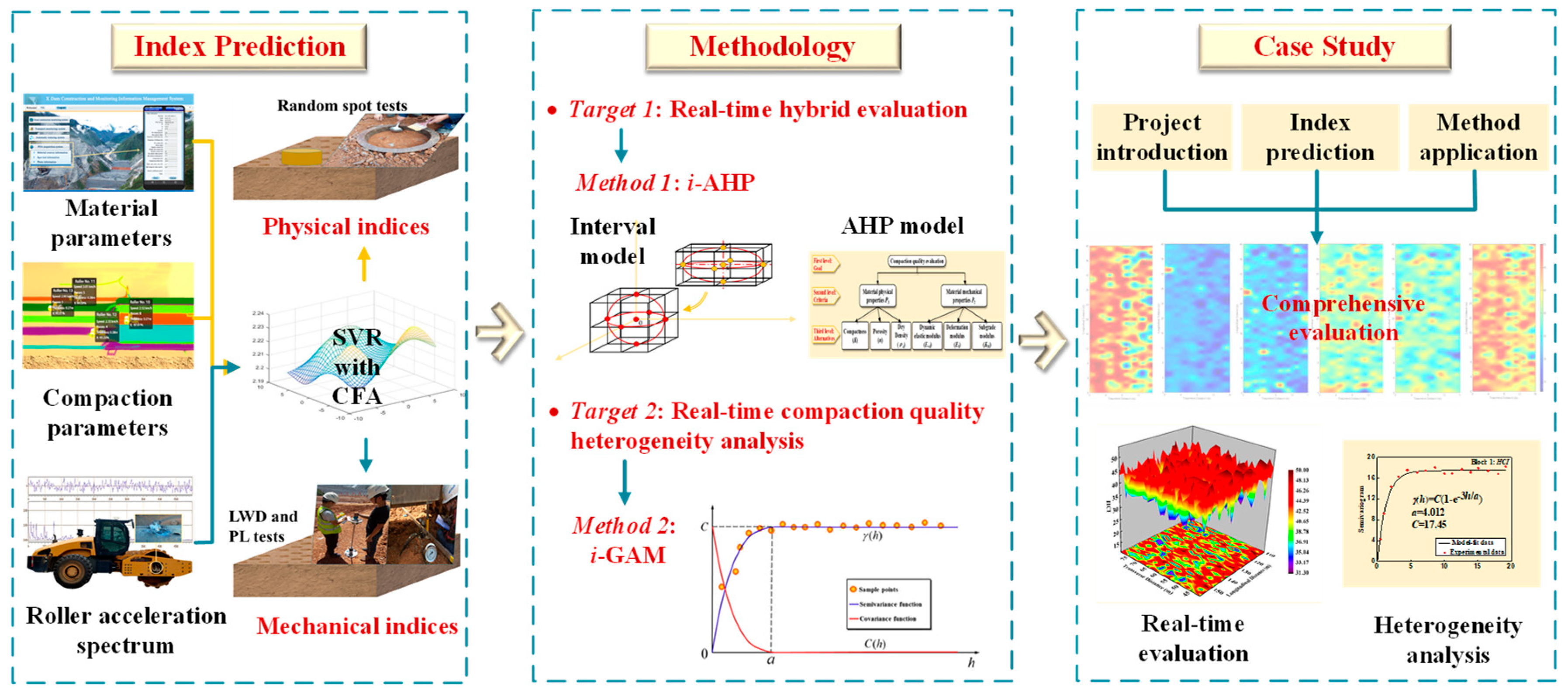


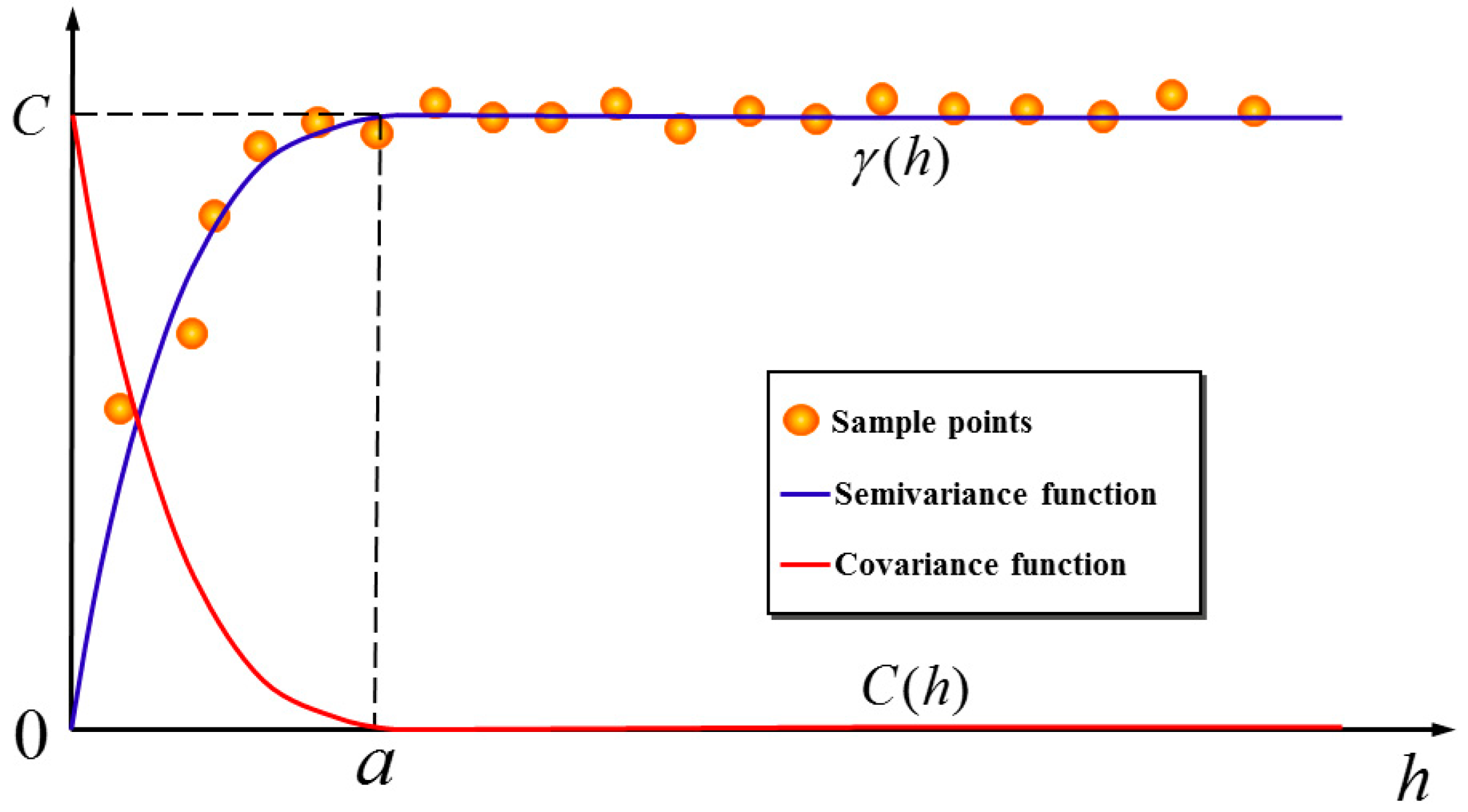
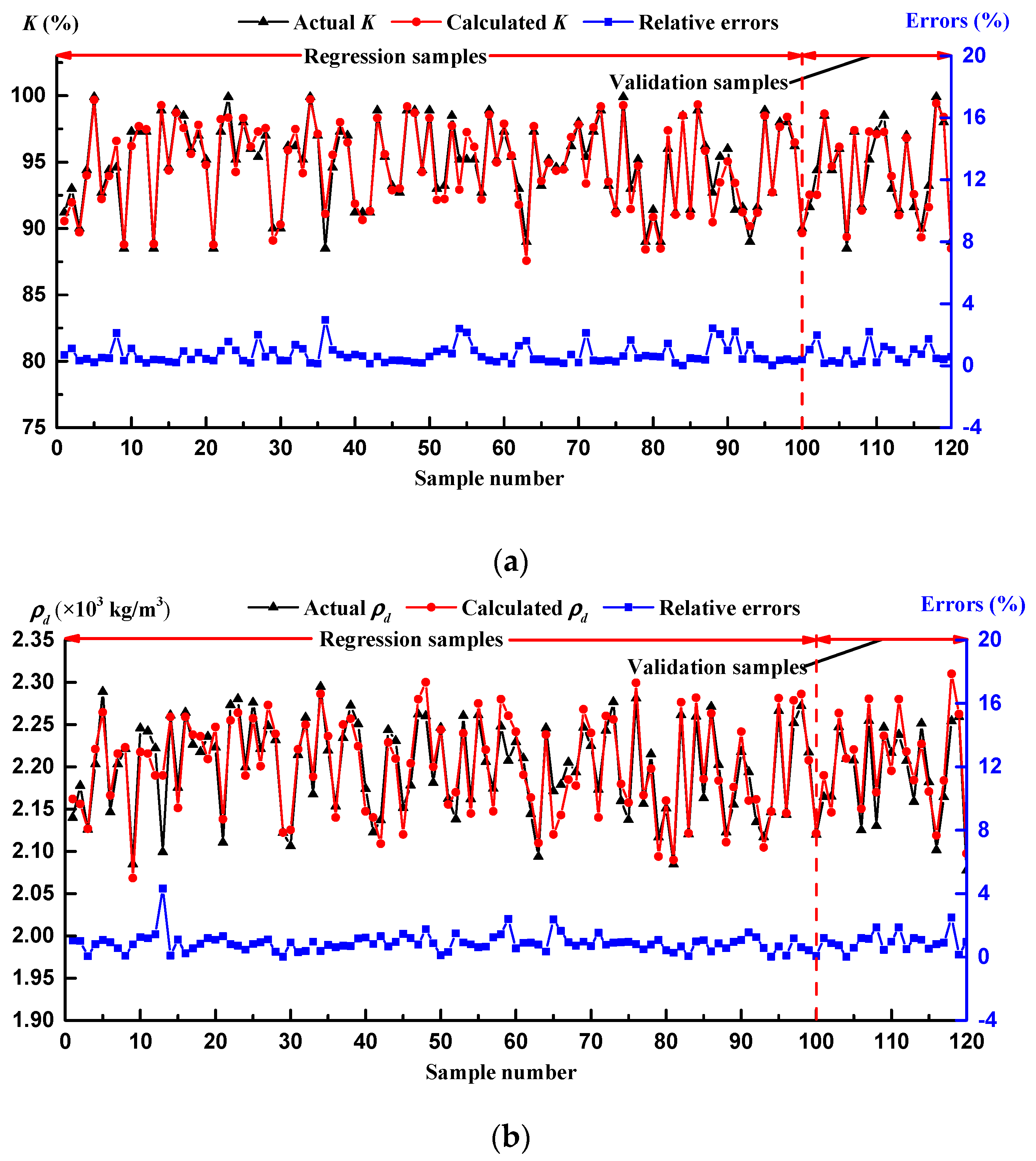
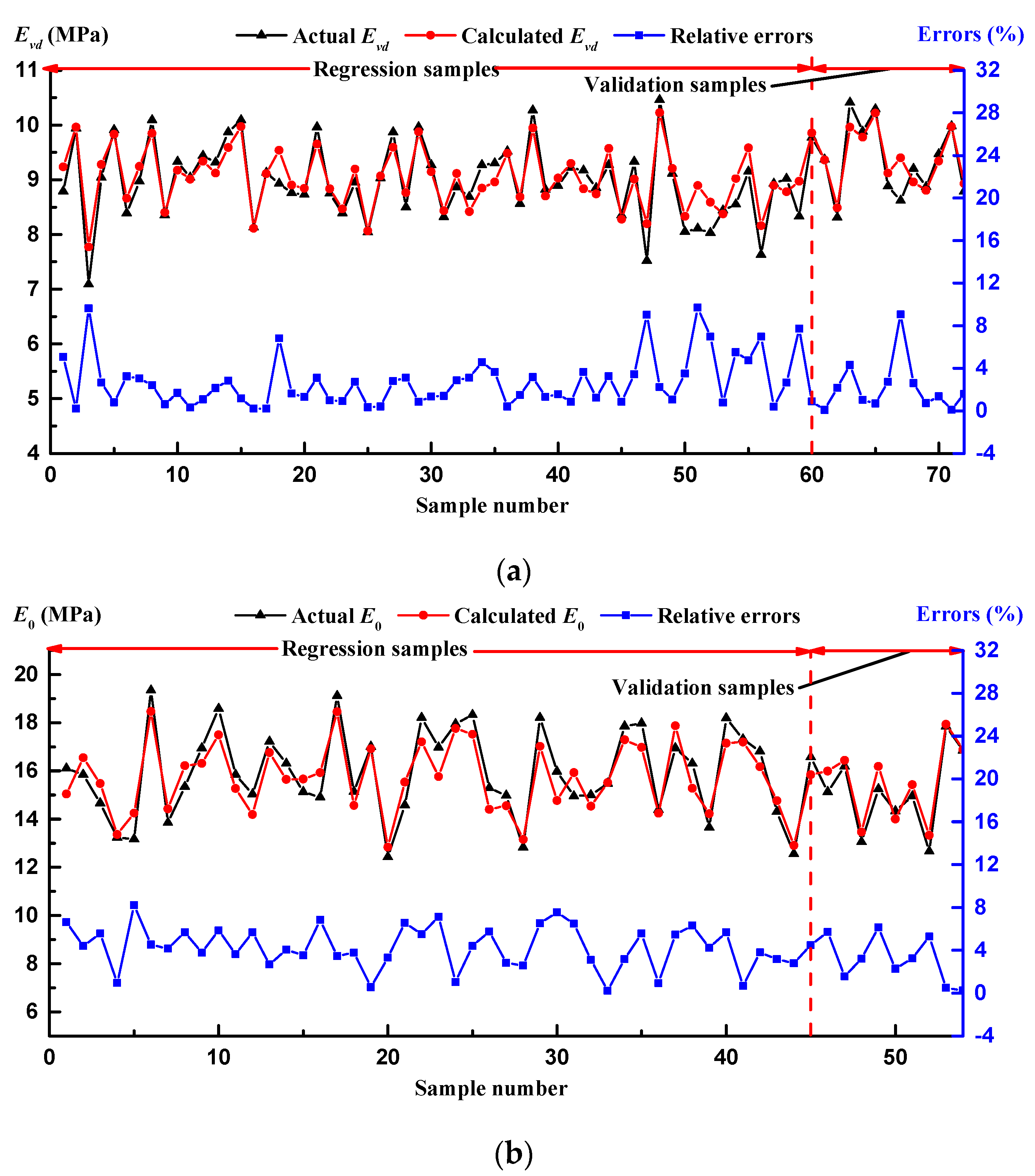
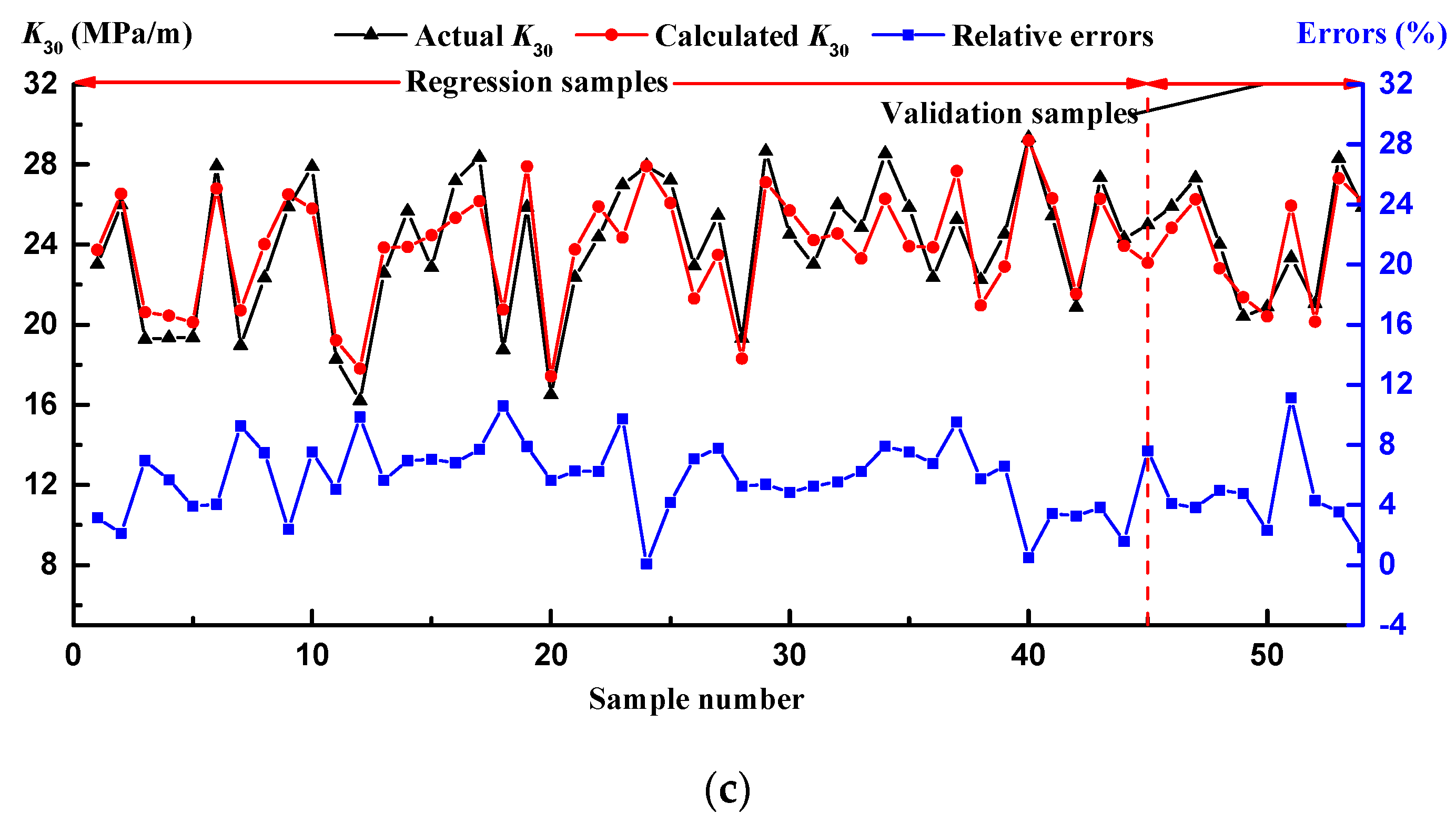
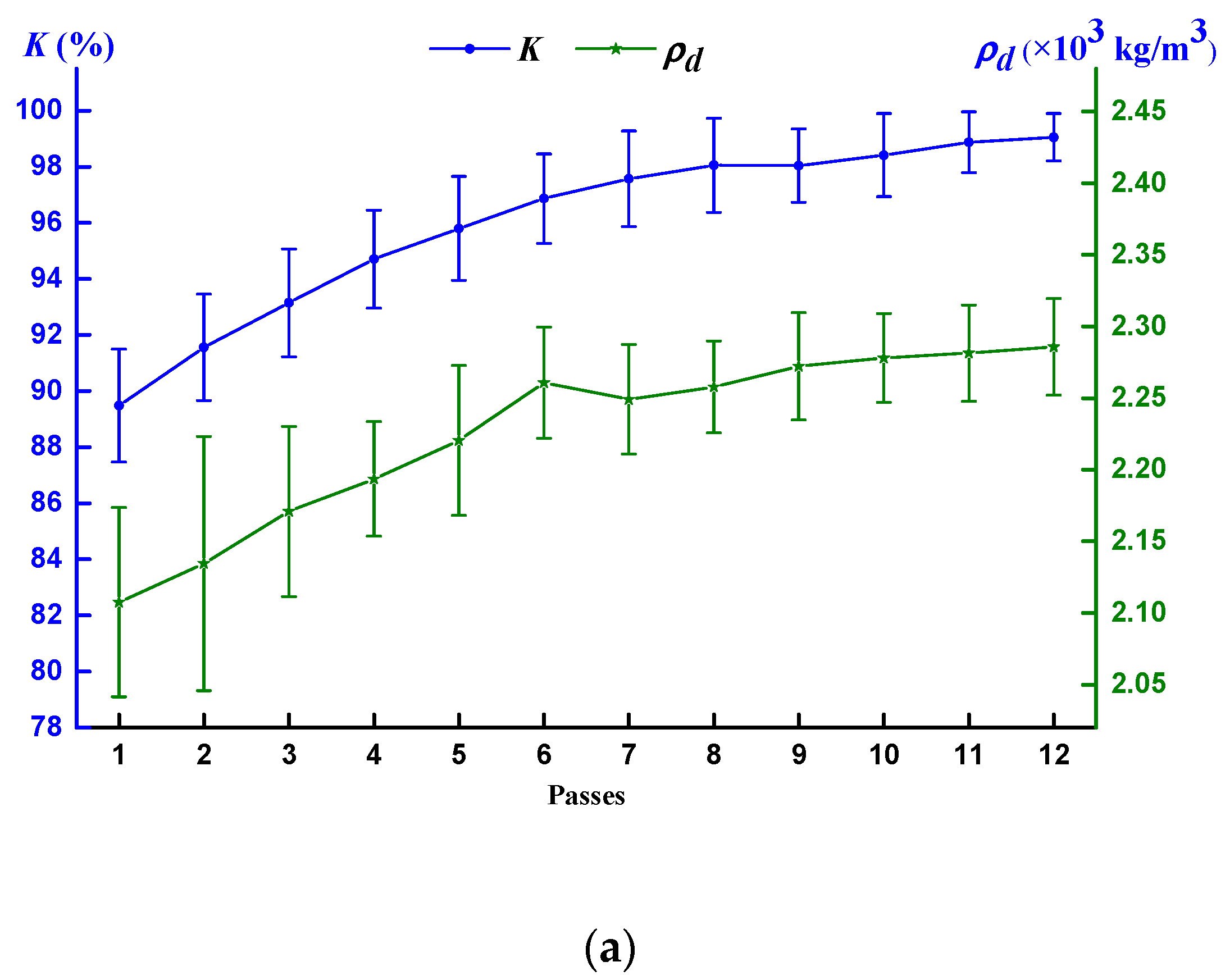
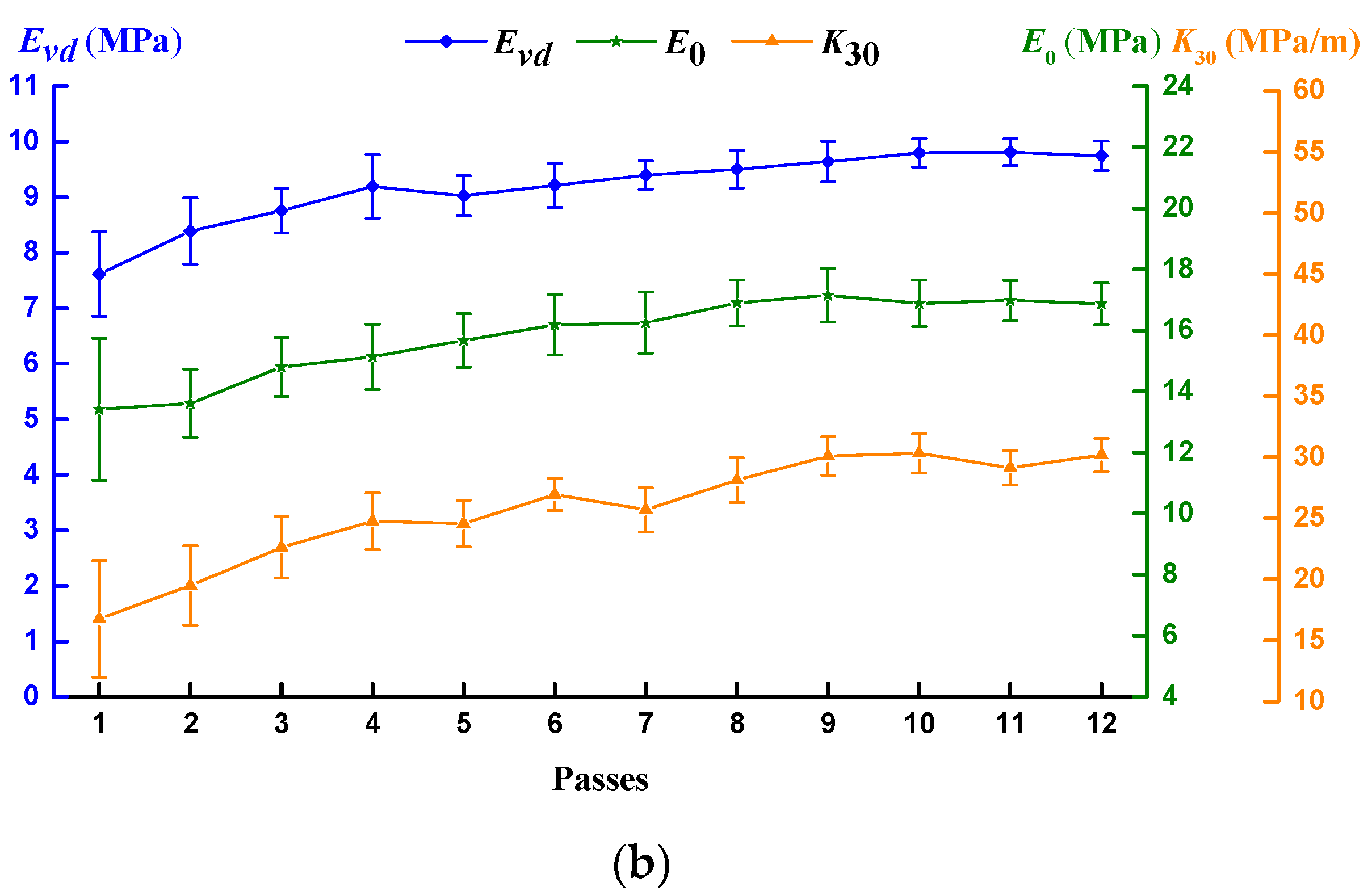
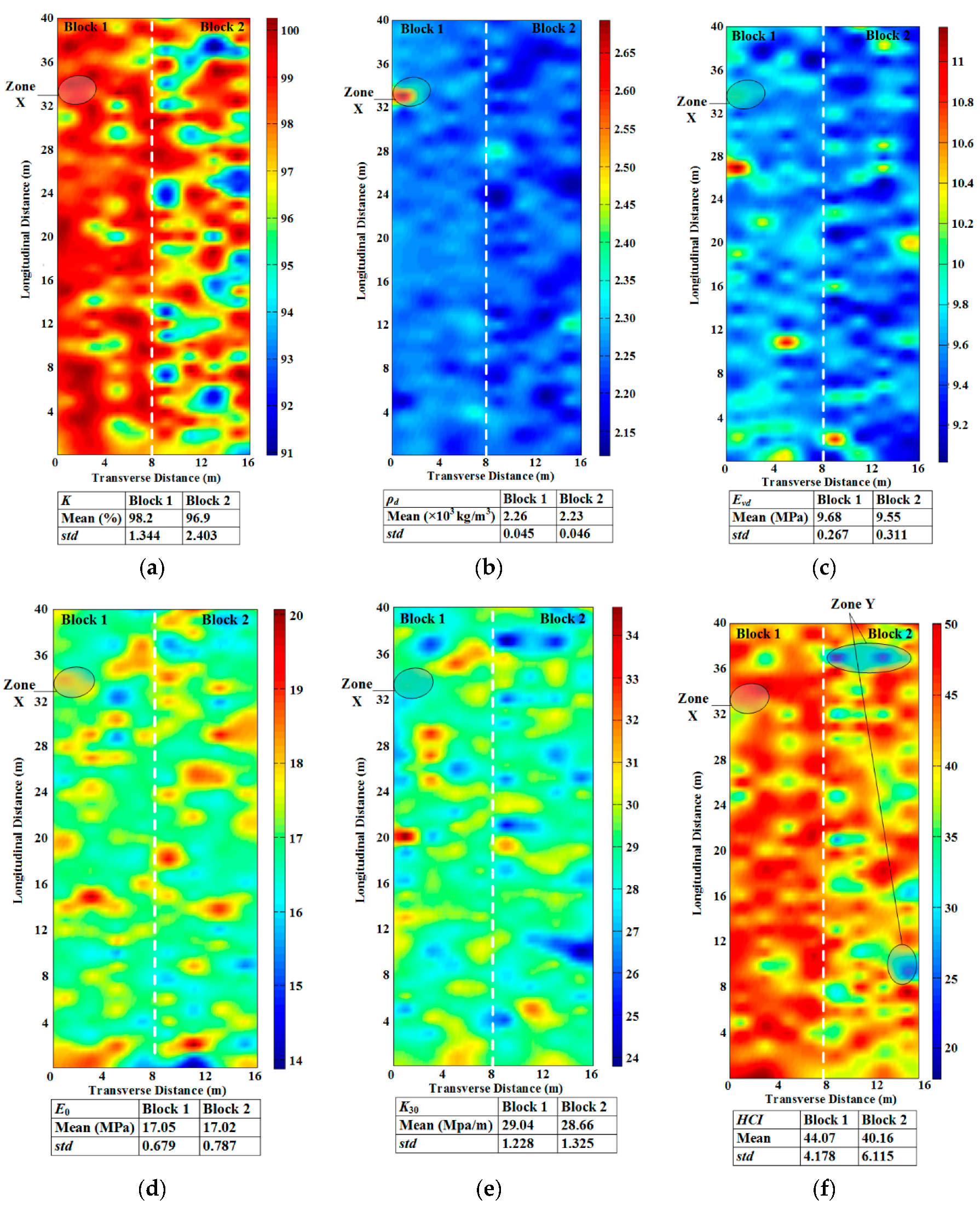
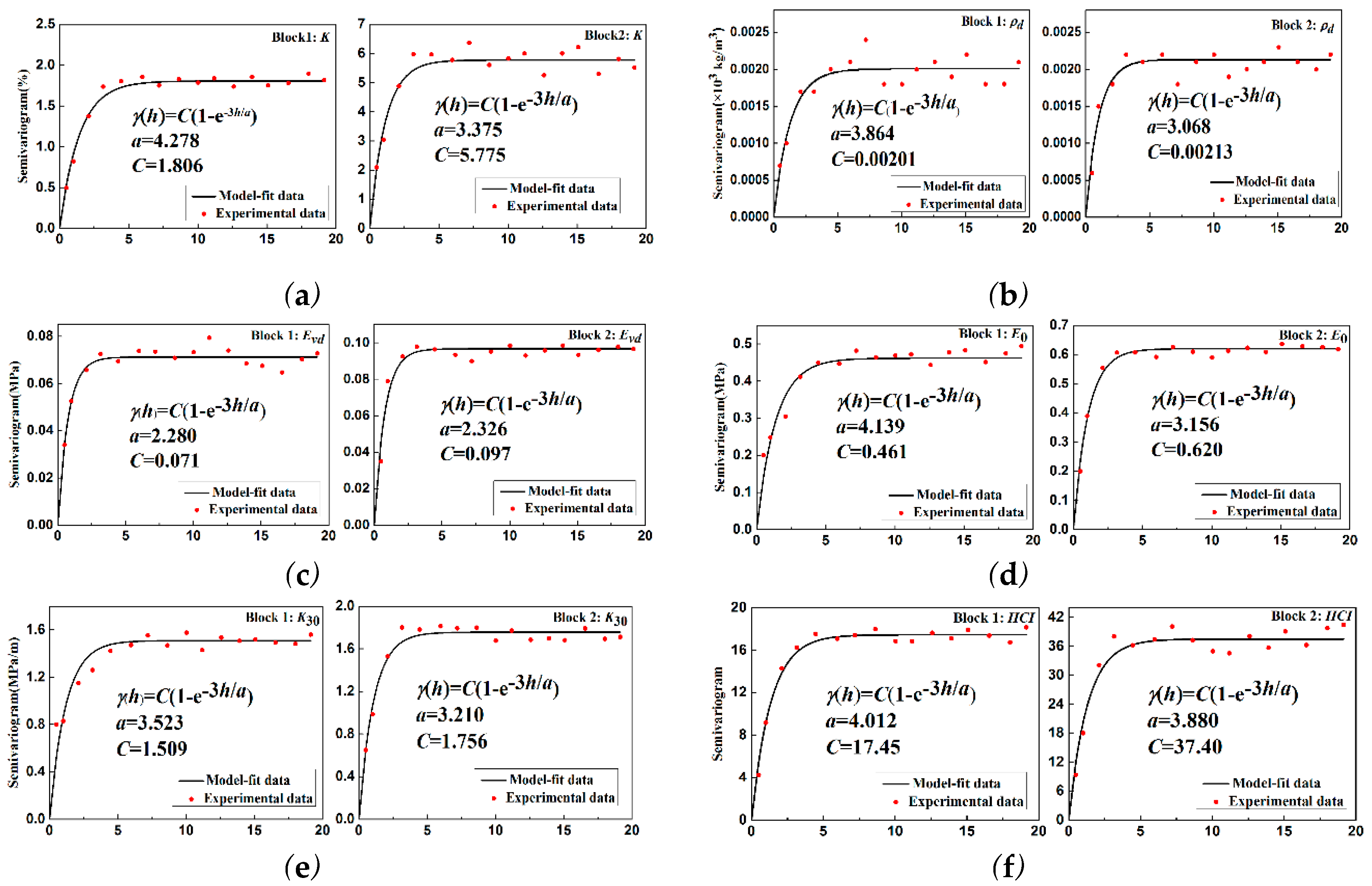
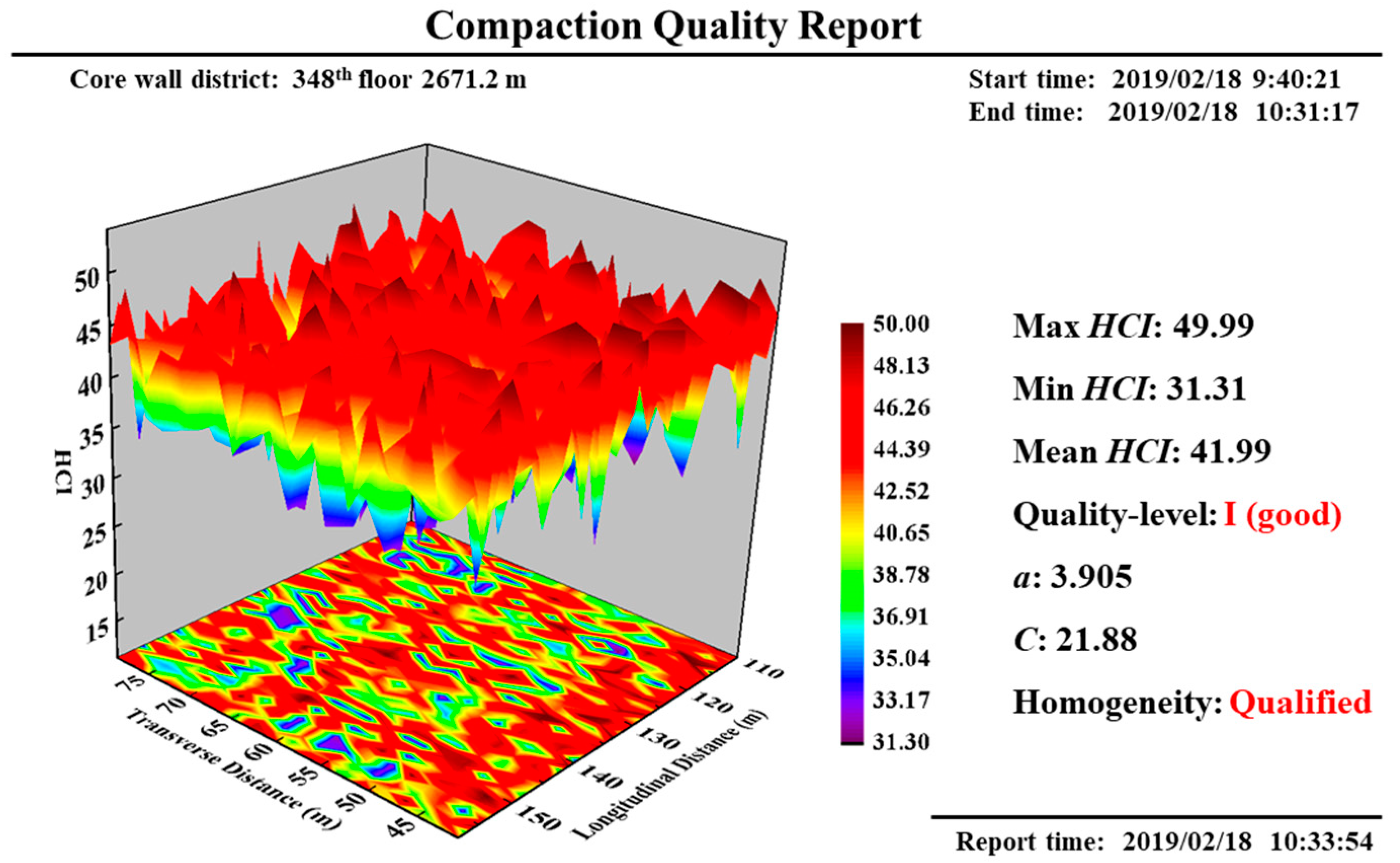
| Categories | Indices | Symbols | Detection Methods | CMI | References |
|---|---|---|---|---|---|
| Physical properties | Compactness | K | Spot tests | IWHR [3] | |
| Porosity | n | Spot tests | IWHR [3] | ||
| Dry density | Spot tests | IWHR [3] | |||
| Mechanical properties | Dynamic elastic modulus | Evd | Light weight deflectometer (LWD) tests | Yu et al. [28] | |
| Deformation modulus | E0 | Plate load (PL) tests | White et al. [29] | ||
| Subgrade modulus | K30 | PL tests | White et al. [29] | ||
| California bearing ratio | CBR | Dynamic cone penetrometer tests | Yu et al. [28] | ||
| Nondestructive alternatives | Density | Nuclear density Gauge tests | IWHR [3] | ||
| Density | Additional mass tests | IWHR [3] | |||
| Compaction meter value | CMV | RTCM technology | √ | Thurner et al. [14] | |
| Compaction value | CV | RTCM technology | √ | Liu et al. [16] | |
| Unit compaction energy | UCE | RTCM technology | √ | Liu et al. [17] | |
| Sound compaction value | SCV | RTCM technology | √ | Zhang et al. [5] | |
| Machine drive power | MDP | RTCM technology | √ | Komandi et al. [30] | |
| Bomag variocontrol | BVC | RTCM technology | √ | Rahman et al. [31] | |
| Soil stiffness | ks | RTCM technology | √ | Anderegg et al. [32,33] |
| Importance Degree | Implication |
|---|---|
| 1 | The two elements are equally important |
| 3 | The former is slightly more important than the later |
| 5 | The former is rather more important than the latter |
| 7 | The former is strongly more important than the latter |
| 9 | The former is absolutely more important than the latter |
| 2, 4, 6, 8 | Indicate the intermediate value of the above adjacent judgments |
| Quality Level | I (Good) | II (Fine) | III (Ordinary) | IV (Poor) | V (Bad) |
|---|---|---|---|---|---|
| >99 | 98–99 | 95–98 | 90–95 | <90 | |
| >2.27 | 2.25–2.27 | 2.23–2.25 | 2.21–2.23 | <2.21 | |
| (MPa) | >9.7 | 9.5–9.7 | 9.3–9.5 | 9.1–9.3 | <9.1 |
| (MPa) | >16.5 | 16–16.5 | 15.5–16 | 15–15.5 | <15 |
| (MPa/m) | >29 | 27.5–29 | 26–27.5 | 24.5–26 | <24.5 |
| Dimensionless value | 50 | 40 | 30 | 20 | 10 |
| Indices | Total Weight Vectors | ||
|---|---|---|---|
© 2019 by the authors. Licensee MDPI, Basel, Switzerland. This article is an open access article distributed under the terms and conditions of the Creative Commons Attribution (CC BY) license (http://creativecommons.org/licenses/by/4.0/).
Share and Cite
Liu, M.; Wang, X.; Wang, J.; Cui, B.; Deng, B.; Shi, M. Comprehensive Evaluation for Real-Time Compaction Quality Using i-AHP and i-GAM: Case Study of Earth-Rock Dam. Appl. Sci. 2019, 9, 1543. https://doi.org/10.3390/app9081543
Liu M, Wang X, Wang J, Cui B, Deng B, Shi M. Comprehensive Evaluation for Real-Time Compaction Quality Using i-AHP and i-GAM: Case Study of Earth-Rock Dam. Applied Sciences. 2019; 9(8):1543. https://doi.org/10.3390/app9081543
Chicago/Turabian StyleLiu, Minghui, Xiaoling Wang, Jiajun Wang, Bo Cui, Boqi Deng, and Mengnan Shi. 2019. "Comprehensive Evaluation for Real-Time Compaction Quality Using i-AHP and i-GAM: Case Study of Earth-Rock Dam" Applied Sciences 9, no. 8: 1543. https://doi.org/10.3390/app9081543
APA StyleLiu, M., Wang, X., Wang, J., Cui, B., Deng, B., & Shi, M. (2019). Comprehensive Evaluation for Real-Time Compaction Quality Using i-AHP and i-GAM: Case Study of Earth-Rock Dam. Applied Sciences, 9(8), 1543. https://doi.org/10.3390/app9081543




